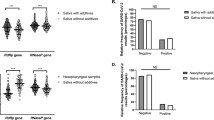Abstract
Molecular detection of enterovirus (EV) RNA based on PCR methods is a quicker and more sensitive approach than culture methods. At present, different PCR-based methods for EV RNA detection are available, but comparisons of results obtained according to the different approaches are limited. We evaluated an in-house real-time RT-PCR assay with a commercialized TaqMan real-time RT-PCR kit for detection of EV. Consecutive clinical specimens from paediatric patients less than 6 years old with clinical suspicion of EV infection were analyzed between July and November 2010. After RNA extraction, samples were amplified both by the real-time RT-PCR commercial assay and the in-house assay. A total of 19 of 132 patients (14.4%) involving 20 samples (14 plasma samples and 6 CSF) were positive in at least one of the two assays. The sensitivity of the in-house assay when the MutaPLATE® assay was used as a reference was 90% (IC 95%; 74.35–100) and the specificity was 100% (IC 95%; 99.63–100). Cts results of two methods were statistically correlated (r = 0.774; P = 0.01). In conclusion, these two real-time RT-PCR assays are rapid and easy methods for detection of EV.


Similar content being viewed by others
References
Tebruegge M, Curtis N (2009) Enterovirus infections in neonates. Semin Fetal Neonatal Med 14(4):222–227
Ooi MH, Wong SC, Lewthwaite P, Cardosa MJ, Solomon T (2010) Clinical features, diagnosis, and management of enterovirus 71. Lancet Neurol 9(11):1097–1105
Jonsson N, Gullberg M, Israelsson S, Lindberg AM (2009) A rapid and efficient method for studies of virus interaction at the host cell surface using enteroviruses and real-time PCR. Virol J 7:6–217
Zhou F, Kong F, McPhie K, Ratnamohan M, Gilbert GL, Dwyer DE (2010) Molecular identification and analysis of nonserotypeable human enteroviruses. J Clin Microbiol 48(4):1276–1282
Benschop K, Minnaar R, Koen G, van Eijk H, Dijkman K, Westerhuis B, Molenkamp R, Wolthers K (2010) Detection of human enterovirus and human parechovirus (HPeV) genotypes from clinical stool samples: polymerase chain reaction and direct molecular typing, culture characteristics, and serotyping. Diagn Microbiol Infect Dis 68(2):166–173
DeBiasi RL, Tyler KL (2004) Molecular methods for diagnosis of viral encephalitis. Clin Microbiol Rev 17(4):903–925
Nix WA, Oberste MS, Pallansch MA (2006) Sensitive, seminested PCR amplification of VP1 sequences for direct identification of all enterovirus serotypes from original clinical specimens. J Clin Microbiol 44(8):2698–2704
Verstrepen WA, Kuhn S, Kockx MM, Van De Vyvere ME, Mertens AH (2001) Rapid detection of enterovirus RNA in cerebrospinal fluid specimens with a novel single-tube real-time reverse transcription-PCR assay. J Clin Microbiol 39(11):4093–4096
Archimbaud C, Mirand A, Chambon M, Regagnon C, Bailly JL, Peigue-Lafeuille H, Henquell C (2004) Improved diagnosis on a daily basis of enterovirus meningitis using a one-step real-time RT-PCR assay. J Med Virol 74(4):604–611
Byington CL, Rittichier KK, Bassett KE et al (2003) Serious bacterial infections in febrile infants younger than 90 days of age: the importance of ampicillin-resistant pathogens. Pediatrics 111:964–968
Khetsuriani N, Lamonte A, Oberste MS et al (2006) Neonatal enterovirus infections reported to the national enterovirus surveillance system in the United States, 1983–2003. Pediatr Infect Dis J 25:889–893
Jordan I, Esteva C, Esteban E, Noguera A, Garcia JJ, Muñoz-Almagro C (2009) Severe enterovirus disease in febrile neonates. Enferm Infecc Microbiol Clin 27(7):399–402
Verboon-Maciolek MA, Thijsen SF, Hemels MA, Menses M, van Loon AM, Krediet TG, Gerards LJ, Fleer A, Voorbij HA, Rijkers GT (2006) Inflammatory mediators for the diagnosis and treatment of sepsis in early infancy. Pediatr Res 59(3):457–461
Acknowledgments
This study was partially supported by Agència d'Avaluació de Tecnologia i Recerca Mèdiques (AATRM) and AGAUR 2009/SGR00136.
We thanks Nuria Cabrerizo for technical support.
Potential conflict of interest
The authors declare no conflict of interest.
Author information
Authors and Affiliations
Corresponding author
Rights and permissions
About this article
Cite this article
Selva, L., Martinez-Planas, A., García-García, JJ. et al. Comparison of an in-house real-time RT-PCR assay with a commercial assay for detection of enterovirus RNA in clinical samples. Eur J Clin Microbiol Infect Dis 31, 715–719 (2012). https://doi.org/10.1007/s10096-011-1364-1
Received:
Accepted:
Published:
Issue Date:
DOI: https://doi.org/10.1007/s10096-011-1364-1




